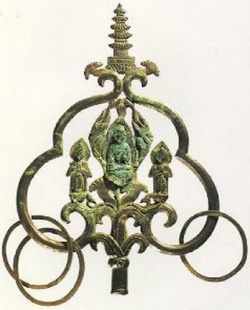Staff
A staff (daṇḍa) is a long stick, usually made of wood, used to assist walking. According to the Vinaya the standard staff should be four hands (hattha) long, i.e. four times the distance from the fingers to the elbow (Vin.IV,200). The Buddha allowed monks to carry a staff when they were traveling while sick (Vin.II,131). Gradually though, all traveling monks would carry staffs. They would use them to push aside prickles, warn off village dogs then they went alms gathering and to protect them from wild animals while traveling through forests. In later centuries a large metal ring with smaller rings through it was attached to the top of the staff. The jingling should made by these rings gave the such staffs their name khakharaka which is an onomatopoeia for this sound. Eventually the khakharaka ceased to be used for practical reasons and became a symbol of authority and would be used by abbots during important ceremonies. Senior Chinese and Tibetan monks still sometimes use a khakharaka.
With the development of Vajrayāna Buddhism a different type of staff came into use. Called khatuanga it had a trident on the top and a human skull through the shaft. Like much of Vajrayāna, such staffs were copied directly from Hindu Siva worship. The trident (trishula) is the symbol of Siva and Siva ascetics were called ‘skull-carriers’ (kapalika). Padmasambhavana, the semi-mythological magician who is credited with bringing Buddhism to Tibet is always depicted carrying one of there staffs. In a sense, these different types of staff illustrate the changes that took place Buddhism – from simple to complex, from practical to symbolic, and finally from a distinct separate religion to being absorbed into Hinduism.
